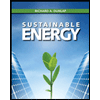Problem 5 It is well established that the thermal efficiency of a heat engine increases as the temperature TL at which heat is rejected from the heat engine decreases. In a effort to increase the efficiency of a power plant, somebody suggests refrigerating the cooling water before it enters the condenser, where heat rejection takes place. Would you be in favor of this idea? Why? Problem 6 A commercial refrigerator with refrigerant-134a as the working fluid is used to keep the refrigerated space at -35°C by rejecting waste heat to cooling water that enters the condenser at 19°C at a rate of 0.3 kg/s and leaves at 25°C. The refrigerant enters the condenser at 1.4 MPa and 60°C and leaves at the same pressure subcooled by 10°C. If the compressor consumes 3.2 kW of power, determine (a) the mass flow rate of the refrigerant, (b) the refrigeration load, (c) the COP, and (d) the minimum power input to the compressor for the same refrigeration load.
Problem 5 It is well established that the thermal efficiency of a heat engine increases as the temperature TL at which heat is rejected from the heat engine decreases. In a effort to increase the efficiency of a power plant, somebody suggests refrigerating the cooling water before it enters the condenser, where heat rejection takes place. Would you be in favor of this idea? Why? Problem 6 A commercial refrigerator with refrigerant-134a as the working fluid is used to keep the refrigerated space at -35°C by rejecting waste heat to cooling water that enters the condenser at 19°C at a rate of 0.3 kg/s and leaves at 25°C. The refrigerant enters the condenser at 1.4 MPa and 60°C and leaves at the same pressure subcooled by 10°C. If the compressor consumes 3.2 kW of power, determine (a) the mass flow rate of the refrigerant, (b) the refrigeration load, (c) the COP, and (d) the minimum power input to the compressor for the same refrigeration load.
Sustainable Energy
2nd Edition
ISBN:9781337551663
Author:DUNLAP, Richard A.
Publisher:DUNLAP, Richard A.
Chapter8: Direct Use Of Solar Energy
Section: Chapter Questions
Problem 14P
Related questions
Question
Please help solve both for homework.

Transcribed Image Text:Problem 5
It is well established that the thermal efficiency of a heat engine increases as the temperature TL at which heat
is rejected from the heat engine decreases. In a effort to increase the efficiency of a power plant, somebody
suggests refrigerating the cooling water before it enters the condenser, where heat rejection takes place.
Would you be in favor of this idea? Why?
Problem 6
A commercial refrigerator with refrigerant-134a as the working fluid is used to keep the refrigerated space
at -35°C by rejecting waste heat to cooling water that enters the condenser at 19°C at a rate of 0.3 kg/s and
leaves at 25°C. The refrigerant enters the condenser at 1.4 MPa and 60°C and leaves at the same pressure
subcooled by 10°C. If the compressor consumes 3.2 kW of power, determine (a) the mass flow rate of the
refrigerant, (b) the refrigeration load, (c) the COP, and (d) the minimum power input to the compressor for
the same refrigeration load.
Expert Solution
This question has been solved!
Explore an expertly crafted, step-by-step solution for a thorough understanding of key concepts.
Step by step
Solved in 2 steps

Recommended textbooks for you


Engineering Fundamentals: An Introduction to Engi…
Civil Engineering
ISBN:
9781305084766
Author:
Saeed Moaveni
Publisher:
Cengage Learning

Materials Science And Engineering Properties
Civil Engineering
ISBN:
9781111988609
Author:
Charles Gilmore
Publisher:
Cengage Learning


Engineering Fundamentals: An Introduction to Engi…
Civil Engineering
ISBN:
9781305084766
Author:
Saeed Moaveni
Publisher:
Cengage Learning

Materials Science And Engineering Properties
Civil Engineering
ISBN:
9781111988609
Author:
Charles Gilmore
Publisher:
Cengage Learning

Solid Waste Engineering
Civil Engineering
ISBN:
9781305635203
Author:
Worrell, William A.
Publisher:
Cengage Learning,

Sustainable Energy
Civil Engineering
ISBN:
9781133108689
Author:
Richard A. Dunlap
Publisher:
Cengage Learning

Construction Materials, Methods and Techniques (M…
Civil Engineering
ISBN:
9781305086272
Author:
William P. Spence, Eva Kultermann
Publisher:
Cengage Learning